Emirates Fleet Airbus A380-800 Details and Pictures. On current Emirates aircraft fleet, there’s 117 (109 on services, and 8 on orders) double deck airliner Airbus A380-800.
Emirates is the largest operator of this largest passenger aircraft.
Emirates massive orders on this super jumbo airliner is the main reason why Airbus A380 project are still alive till today.
Emirates configured this aircraft with 3 configuration, 2 configuration with 3 class cabin, and 1 configuration with 2 class cabin.
Flying on Emirates A380 is as close as it comes to your own private jet.
It’s an unsurpassed experience – from private suites and Shower Spas in First Class to flat-bed seats in Business Class and extra room and custom lighting in Economy Class.
With the airline’s central location in the Middle East, Emirates A380s serve over 35 destinations in Europe, Asia, Australia and North America.
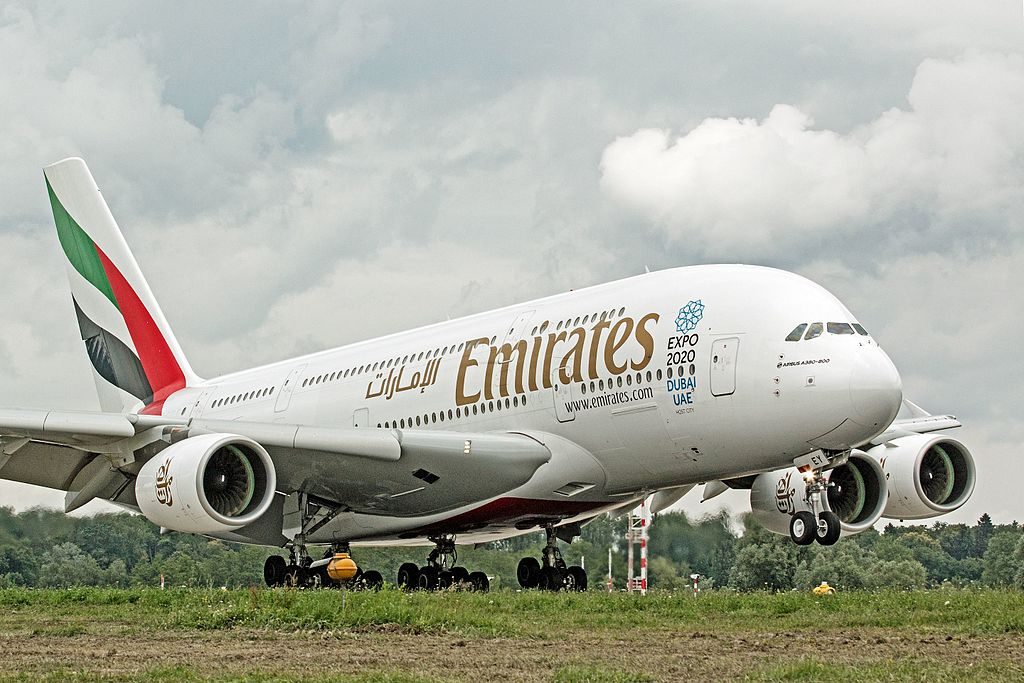
Airbus A380-800 Emirates Aircraft Fleet Data and Registration Number
| Aircraft Type | Reg | Delivered | Prev. Reg |
| Airbus A380-800 | A6-EDF | Dec 2009 | F-WWJB |
| Airbus A380-800 | A6-EDJ | Jun 2010 | F-WWEA |
| Airbus A380-800 | A6-EDA | Jul 2008 | D-AXAA |
| Airbus A380-800 | A6-EDB | Oct 2008 | D-AXAB |
| Airbus A380-800 | A6-EDC | Nov 2008 | D-AXAC |
| Airbus A380-800 | A6-EDE | Apr 2009 | D-AXAE |
| Airbus A380-800 | A6-EDD | Dec 2008 | D-AXAD |
| Airbus A380-800 | A6-EDG | Dec 2009 | F-WWST |
| Airbus A380-800 | A6-EDH | Jan 2010 | F-WWSV |
| Airbus A380-800 | A6-EDI | May 2010 | F-WWSZ |
| Airbus A380-800 | A6-EDK | Jul 2010 | F-WWSD |
| Airbus A380-800 | A6-EDM | Sep 2010 | F-WWAO |
| Airbus A380-800 | A6-EDL | Aug 2010 | F-WWAG |
| Airbus A380-800 | A6-EDN | Nov 2010 | F-WWAR |
| Airbus A380-800 | A6-EDO | Nov 2010 | F-WWAS |
| Airbus A380-800 | A6-EDP | Oct 2011 | F-WWSY |
| Airbus A380-800 | A6-EDQ | Oct 2011 | F-WWSV |
| Airbus A380-800 | A6-EDR | Nov 2011 | F-WWSZ |
| Airbus A380-800 | A6-EDS | Dec 2011 | F-WWSB |
| Airbus A380-800 | A6-EDT | Dec 2011 | F-WWSE |
| Airbus A380-800 | A6-EDU | Feb 2012 | F-WWAB |
| Airbus A380-800 | A6-EDV | Jul 2012 | F-WWAG |
| Airbus A380-800 | A6-EDW | Aug 2012 | F-WWAL |
| Airbus A380-800 | A6-EDX | Oct 2012 | F-WWAK |
| Airbus A380-800 | A6-EDY | Oct 2012 | F-WWAS |
| Airbus A380-800 | A6-EDZ | Oct 2012 | F-WWSD |
| Airbus A380-800 | A6-EEA | Dec 2012 | F-WWSI |
| Airbus A380-800 | A6-EEB | Nov 2012 | F-WWSN |
| Airbus A380-800 | A6-EEC | Nov 2012 | F-WWAE |
| Airbus A380-800 | A6-EED | Dec 2012 | F-WWAQ |
| Airbus A380-800 | A6-EEE | Dec 2012 | F-WWAU |
| Airbus A380-800 | A6-EEF | May 2013 | F-WWSJ |
| Airbus A380-800 | A6-EEG | May 2013 | F-WWSS |
| Airbus A380-800 | A6-EEH | Jun 2013 | F-WWSY |
| Airbus A380-800 | A6-EEI | Jun 2013 | F-WWAM |
| Airbus A380-800 | A6-EEJ | Sep 2013 | F-WWAZ |
| Airbus A380-800 | A6-EEK | Aug 2013 | F-WWSF |
| Airbus A380-800 | A6-EEL | Nov 2013 | F-WWSH |
| Airbus A380-800 | A6-EEM | Nov 2013 | F-WWSP |
| Airbus A380-800 | A6-EEN | Nov 2013 | F-WWSR |
| Airbus A380-800 | A6-EEO | Oct 2013 | F-WWAX |
| Airbus A380-800 | A6-EEP | Dec 2013 | F-WWAF |
| Airbus A380-800 | A6-EER | Dec 2013 | F-WWSB |
| Airbus A380-800 | A6-EES | Dec 2013 | F-WWAD |
| Airbus A380-800 | A6-EEQ | Feb 2014 | F-WWAG |
| Airbus A380-800 | A6-EET | Mar 2014 | F-WWAH |
| Airbus A380-800 | A6-EEU | Mar 2014 | F-WWAR |
| Airbus A380-800 | A6-EEV | May 2014 | F-WWSA |
| Airbus A380-800 | A6-EEW | Jun 2014 | F-WWAE |
| Airbus A380-800 | A6-EEX | Jul 2014 | F-WWAN |
| Airbus A380-800 | A6-EEY | Sep 2014 | F-WWAV |
| Airbus A380-800 | A6-EEZ | Aug 2014 | F-WWAU |
| Airbus A380-800 | A6-EOA | Sep 2014 | F-WWSE |
| Airbus A380-800 | A6-EVB | Nov 2018 | F-WWSL |
| Airbus A380-800 | A6-EOB | Nov 2014 | F-WWSO |
| Airbus A380-800 | A6-EOC | Nov 2014 | F-WWSJ |
| Airbus A380-800 | A6-EVA | Apr 2018 | F-WWSN |
| Airbus A380-800 | A6-EOD | Dec 2014 | F-WWSY |
| Airbus A380-800 | A6-EOE | Dec 2014 | F-WWSZ |
| Airbus A380-800 | A6-EOF | Jan 2015 | F-WWAM |
| Airbus A380-800 | A6-EOG | Mar 2015 | F-WWAX |
| Airbus A380-800 | A6-EOH | Apr 2015 | F-WWSH |
| Airbus A380-800 | A6-EOI | May 2015 | F-WWAD |
| Airbus A380-800 | A6-EOJ | Jun 2015 | F-WWSF |
| Airbus A380-800 | A6-EOK | Jul 2015 | F-WWSU |
| Airbus A380-800 | A6-EOL | Jul 2015 | F-WWAG |
| Airbus A380-800 | A6-EOM | Aug 2015 | F-WWAH |
| Airbus A380-800 | A6-EON | Sep 2015 | F-WWAK |
| Airbus A380-800 | A6-EOO | Sep 2015 | F-WWAR |
| Airbus A380-800 | A6-EOP | Nov 2015 | F-WWSV |
| Airbus A380-800 | A6-EOQ | Nov 2015 | F-WWAN |
| Airbus A380-800 | A6-EOR | Dec 2015 | F-WWAP |
| Airbus A380-800 | A6-EOS | Dec 2015 | F-WWAQ |
| Airbus A380-800 | A6-EOT | Dec 2015 | F-WWAT |
| Airbus A380-800 | A6-EOU | Jan 2016 | F-WWSX |
| Airbus A380-800 | A6-EOV | Feb 2016 | F-WWSE |
| Airbus A380-800 | A6-EOW | Mar 2016 | F-WWSJ |
| Airbus A380-800 | A6-EOX | Apr 2016 | F-WWSM |
| Airbus A380-800 | A6-EOY | Apr 2016 | F-WWSO |
| Airbus A380-800 | A6-EOZ | May 2016 | F-WWST |
| Airbus A380-800 | A6-EUA | May 2016 | F-WWSY |
| Airbus A380-800 | A6-EUB | Jun 2016 | F-WWSZ |
| Airbus A380-800 | A6-EUC | Sep 2016 | F-WWAJ |
| Airbus A380-800 | A6-EUD | Jun 2016 | F-WWAM |
| Airbus A380-800 | A6-EUE | Aug 2016 | F-WWAU |
| Airbus A380-800 | A6-EUF | Oct 2016 | F-WWAV |
| Airbus A380-800 | A6-EUG | Oct 2016 | F-WWAB |
| Airbus A380-800 | A6-EUH | Nov 2016 | F-WWAD |
| Airbus A380-800 | A6-EUI | Feb 2017 | F-WWAF |
| Airbus A380-800 | A6-EUJ | Nov 2016 | F-WWAX |
| Airbus A380-800 | A6-EUK | Dec 2016 | F-WWSH |
| Airbus A380-800 | A6-EUL | Dec 2016 | F-WWSP |
| Airbus A380-800 | A6-EUM | Dec 2016 | F-WWSQ |
| Airbus A380-800 | A6-EUN | Dec 2016 | F-WWSR |
| Airbus A380-800 | A6-EUO | Dec 2016 | F-WWSA |
| Airbus A380-800 | A6-EUP | Mar 2017 | F-WWSC |
| Airbus A380-800 | A6-EUQ | May 2017 | F-WWSF |
| Airbus A380-800 | A6-EUR | Mar 2018 | F-WWAE |
| Airbus A380-800 | A6-EUS | Nov 2017 | F-WWAN |
| Airbus A380-800 | A6-EUT | Nov 2017 | F-WWAP |
| Airbus A380-800 | A6-EUU | Jun 2018 | F-WWAY |
| Airbus A380-800 | A6-EUV | Nov 2017 | F-WWSB |
| Airbus A380-800 | A6-EUW | Sep 2018 | F-WWSE |
| Airbus A380-800 | A6-EUX | Jul 2017 | F-WWSG |
| Airbus A380-800 | A6-EUY | Aug 2017 | F-WWSX |
| Airbus A380-800 | A6-EUZ | Sep 2017 | F-WWAT |
| Airbus A380-800 | A6-EVE | Nov 2018 | F-WWSU |
| Airbus A380-800 | A6-EVF | Dec 2018 | F-WWSY |
| Airbus A380-800 | A6-EVH | Dec 2018 | F-WWAX |
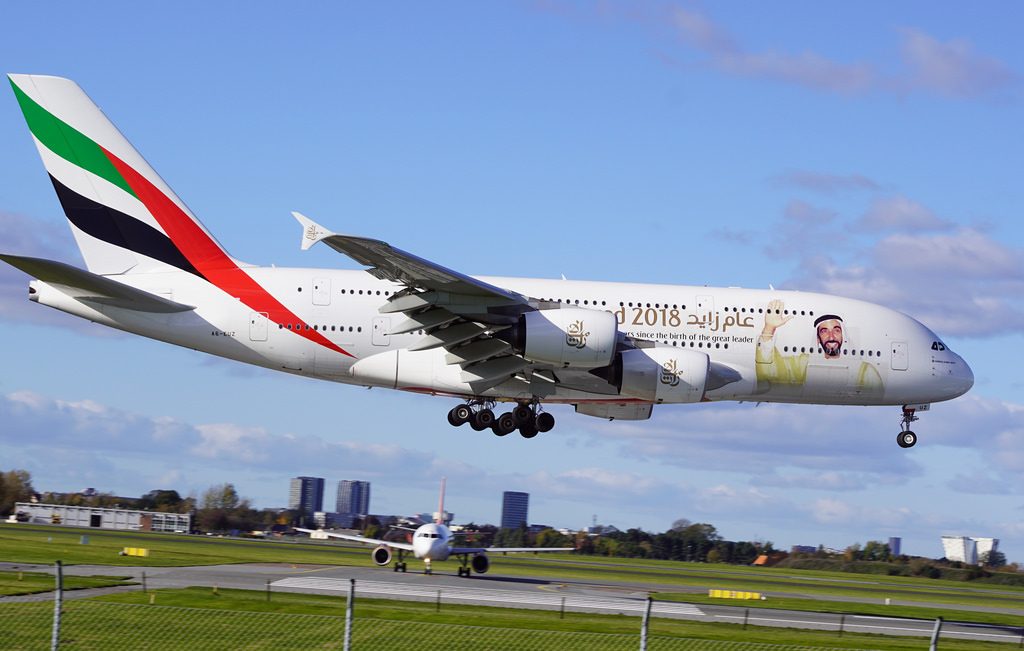
Emirates Fleet Airbus A380-800 Cabin Interior Class Configuration and Seats Layout
Emirates operates three versions of the Airbus A380-800 with slightly different configurations.
- A380-800 Three Class V1. This aircraft operates with three classes of service. First Class are individual suites with sliding doors. There is also a shower for First Class passengers. Business Class is in a staggered pattern with most seats having direct access to the aisle and a pair of seats down the centre. Economy Class is located entirely on the main deck of the aircraft. This version has fewer Economy Class seats. To verify the correct version of the A380 at the time of booking or at online check-in, the follow rows may be used as reference: Economy begins at row 43 on the main deck; Business Class ends at row 26 on the upper deck. Every seat is equipped with inflight power and individual entertainment.
- A380-800 Three Class V2. This aircraft operates with three classes of service. First Class are individual suites with sliding doors. There is also a shower for First Class passengers. Business Class is in a staggered pattern with most seats having direct access to the aisle and a pair of seats down the centre. Economy Class is located entirely on the main deck of the aircraft. This version has a total of 14 First Class seats, 76 Business Class seasts, and 427 Economy Class seats. To verify the correct version of the A380 at the time of booking or at online checking, the follow rows may be used as reference: Economy begins at row 41 on the main deck and ends at row 88; Business Class ends at row 26 on the upper deck. Every seat is equipped with inflight power and individual entertainment.
- A380-800 Two Class. This aircraft operates with two classes of service. Business Class is in a staggered pattern with most seats having direct access to the aisle and a pair of seats down the centre. This version has a total of 58 flat bed Business Class seats, and 557 standard Economy Class seats.
Seat Map and Seating Chart Airbus A380-800 Emirates Three Class V1 Lower Deck

The Lower deck consists of 399 seats of the economy class.
These seats are divided from each other with exit rows into four sections.
First section has 9 rows of seats.
Passengers with infants are often seated on the seats of the 43rf row as these seats have bassinet locations.
Among disadvantages of these seats: reduced width because the armrests are immovable and close location of the stairs and lavatories.

Passengers of the seats 45DEFGwill take advantage of extra legroom.
These seats also have bassinet locations.
The seat 45D is often bumped by other passengers and crew members passing by.
The only disadvantage of the seats 50ABC, 50 HJK and 51DEFG is proximity of the galleys the noise from which may be bothersome.
The second section of economy class has 15 rows.
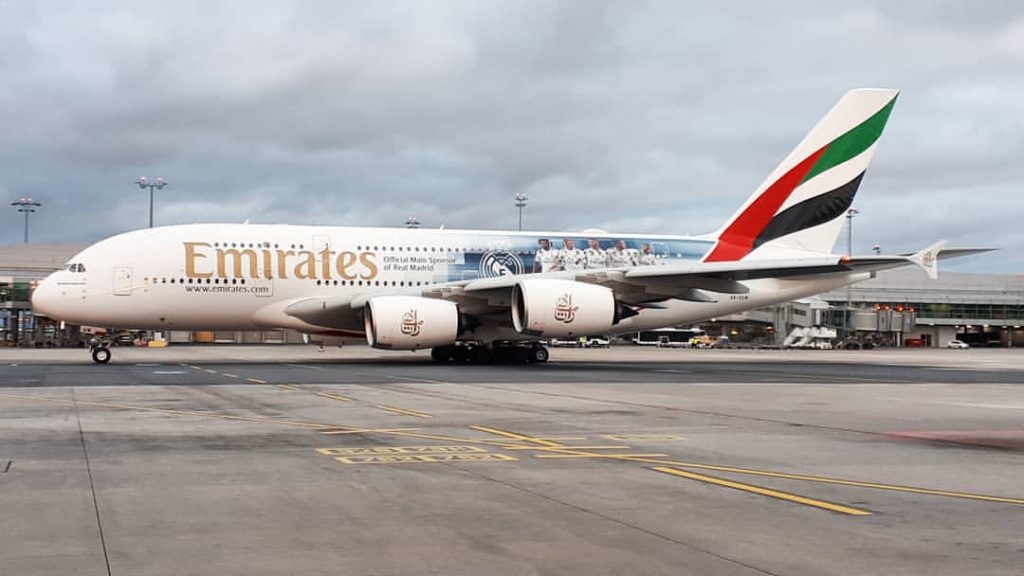
The seats of the 52nd row are first reserved for passengers with babies as these seats have bassinet locations.
The main disadvantage is proximity of the galleys.
The seats 54DEFG are considered good seats as they offer extra space for passengers.
Also these seats have bassinets.
Passengers tend to congregate in the area of the seats 65ABC, 65DEFG, 65H and 66HJK while waiting to use lavatories and causing discomfort to passengers of these seats.
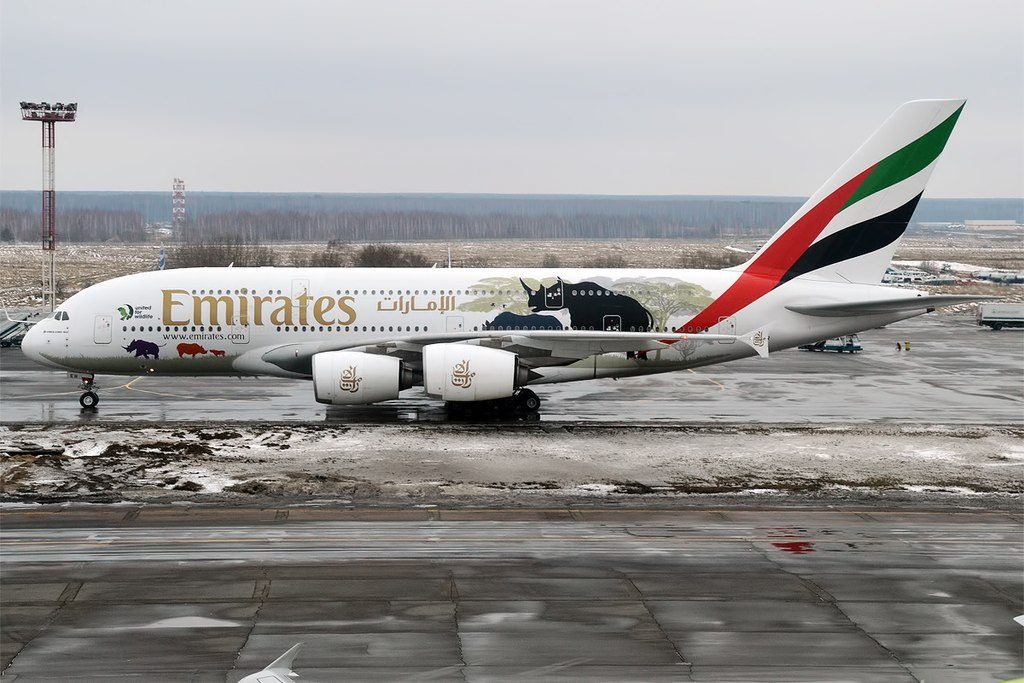
Also these seats are less reclining than standard.
13 rows of seats are located in the third section.
Passengers of the seats of the 67th row will feel comfortable thanks to extra legroom.
As other passengers gather in the area of these seats while waiting to visit lavatories it may cause inconvenience to passengers of these seats.
Passengers with infants are often seated on the seats 67DEFG.

The best seats in these section are seats 68A and 68K.
These seats have extra legroom due to missing seats in front.
Limited recline and location of the galley behind are the disadvantages of the seats 78DEFG.
Proximity of the galley may also cause discomfort to passengers of the seats of the 79th row.
The last section of economy class seats consists of 9 rows.
The seats of the 80th row have extra space for passengers legs.
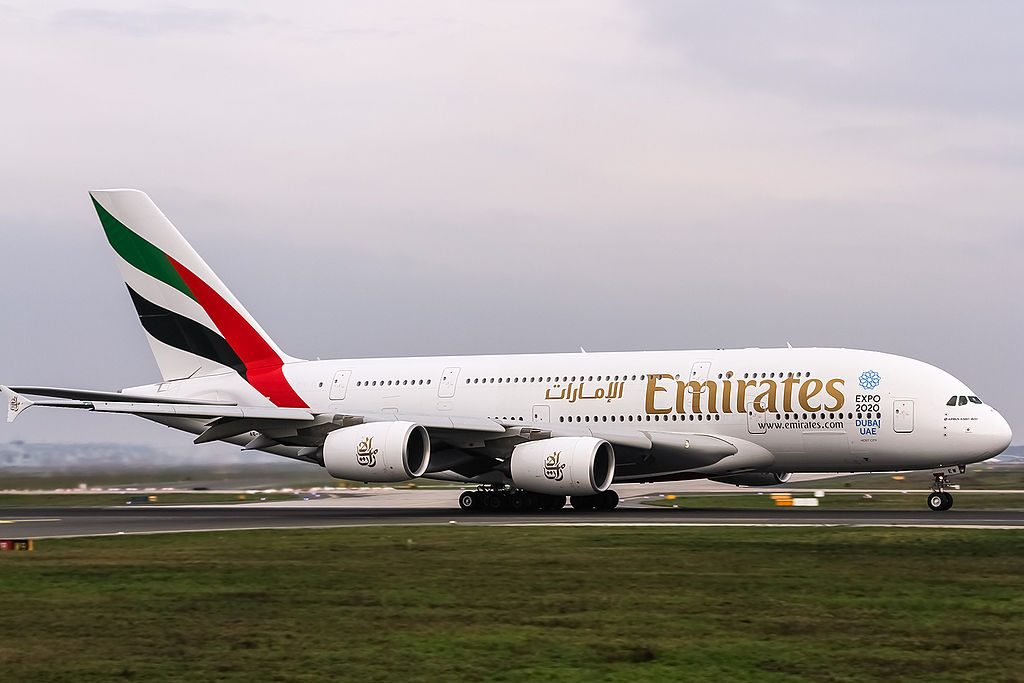
However the noise from the galleys located nearby may cause discomfort.
Due to missing seats in front the seats 81A and 81Khave extra space for passengers’ legs.
The seats 82DEFG offer extra legroom as well.
Passengers traveling with babies are often seated on these seats as they have bassinets.
Proximity of the lavatories may represent a problem to passengers of the seats 87C, 87H and of the seats of the 88th row.
In addition the seats of the 88th row are less reclining than standard.
Seat Map and Seating Chart Airbus A380-800 Emirates Three Class V1 Upper Deck

In the upper deck the seats of the first class and business class are located.
First class consists of 14 closed suites.
The seats of the 1st row have such a disadvantage as close location of the bar.
Proximity of the lavatory and galley is a disadvantage for the seats 4A and 4K.
Business class may accommodate 76 passengers on flat bed seats divided into two sections.
First section contains 15 rows of seats.
The seats 6DG have bassinets for passengers traveling with infants.
Close location of the lavatory may cause discomfort to passengers of these seats.
All other seats of this section are standard.
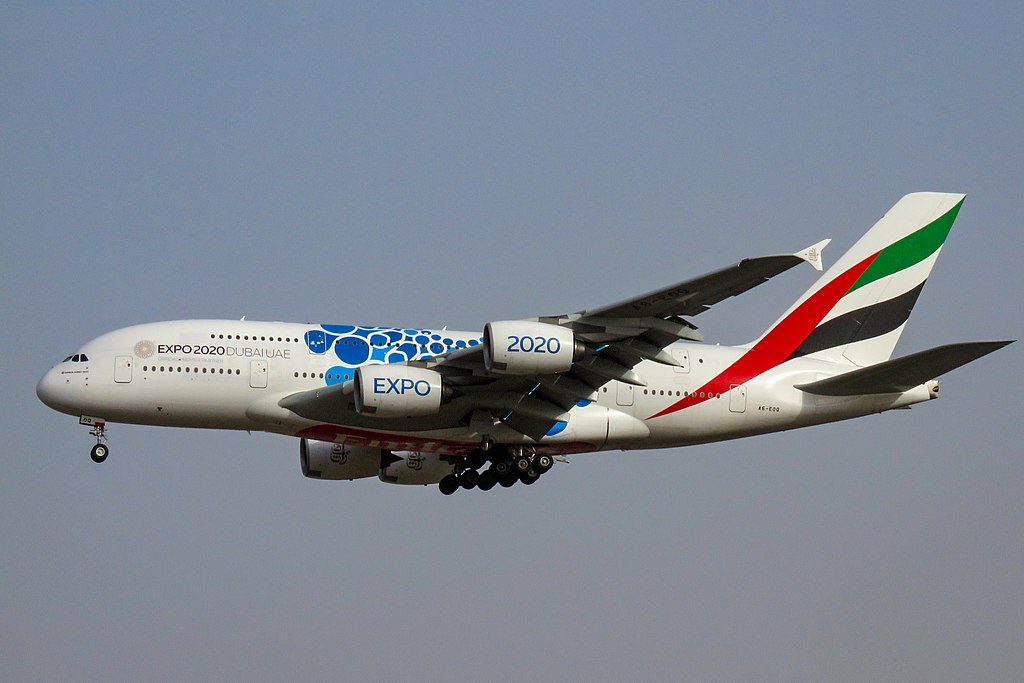
Behind the exit row the second section of business class seats is located.
There are 5 rows of seats here.
The best seats are the seats 22D and 22G.
These seats offer extra legroom.
There are bassinets here for passengers with babies.
The noise coming from the bar and lavatories may cause discomfort to passengers of the seats of the 26th row.
Seat Map and Seating Chart Airbus A380-800 Emirates Three Class V2 Lower Deck

This version of Airbus A380-800 operated by Emirates may transport 517 passengers in three classes: first, economy and business.
The lower deck contains 427 standard seats of the economy class that are located in 4 sections.
First section contains 88 seats.
Passengers of the seats of the 41st row will take advantage of extra space for their legs.
Other passengers tend to congregate in the area of these seats while waiting to use lavatories and causing discomfort to passengers of these seats.
Protrusion of the exit door may slightly restrict extra legroom of the seats 41A and 41K.
The best seats in this section are the seats 45DEFG.
These seats have extra legroom.
Passengers with babies may seat her as these seats have bassinet locations.
Limited recline and close location of the galleys are the disadvantages of the seats 50ABC, 50HJK and 51DEFG.
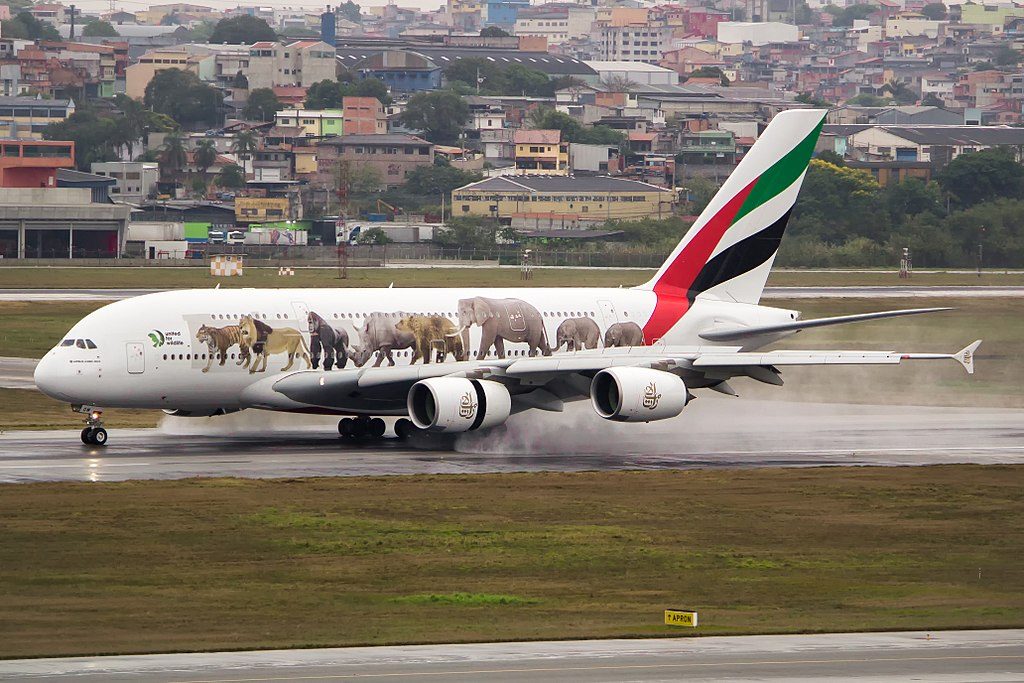
Second section of economy class may accommodate 135 passengers.
For passengers with babies the seats 52ABC, 52HJK and 54 DEFG are equipped with bassinets.
The seats of the 52nd row offer extra legroom but close location of the galleys will cause discomfort.
Passengers of the seats 54DEFG will also take advantage of extra space for their legs.
The only disadvantage of the seat 65H is close location of the lavatories.
The seats 65ABC, 65DEFG and 66HJK are less reclining than standard, proximity of the lavatories is another disadvantage.
The third section includes 124 seats.
Due to exit row located in front the seats of the 67th row have extra space for passengers’ legs.
However, other passengers tend to gather in the area of these seats while waiting to use lavatories causing discomfort to passengers.
Passengers with infants are often seated on the seats 67DEFG as they offer bassinets.

The seats 68A and 68K are the best seats of this section.
Due to missing seats in front passengers of these seats will take advantage of extra legroom.
Close location of the galley and limited recline are the main disadvantages of the seats 78DEFG and of the seats of the 79th row.
The fourth and the last section of the economy class seats contains 80 seats.
The seats of the 80th row have extra legroom.
However the noise from the galley may cause discomfort.
As there are no seats in front, passengers of the seats 81A and 81K will feel comfortable.
The seats 82DEFG have extra legroom as well.
In addition these seats have bassinets.
Proximity of the lavatory is the only disadvantage of the seats 88C, 88D, 88G and 88H.
Limited recline and close location of the lavatory make the seats of the 88th row bad seats.
Seat Map and Seating Chart Airbus A380-800 Emirates Three Class V2 Upper Deck

The Upper deck may accommodate 90 passenger: 14 in the first class and 76 in the business class.
First class offers 14 closed suites.
The noise from the bar located near the seats of the first row may cause discomfort to passengers of these seats.
Disadvantage of the seats 4A and 4K is proximity of the galleys and lavatory.
Behind the exit row the flat bed seats of business class are located.
Most of the seats in business class have 1-2-1 configuration.
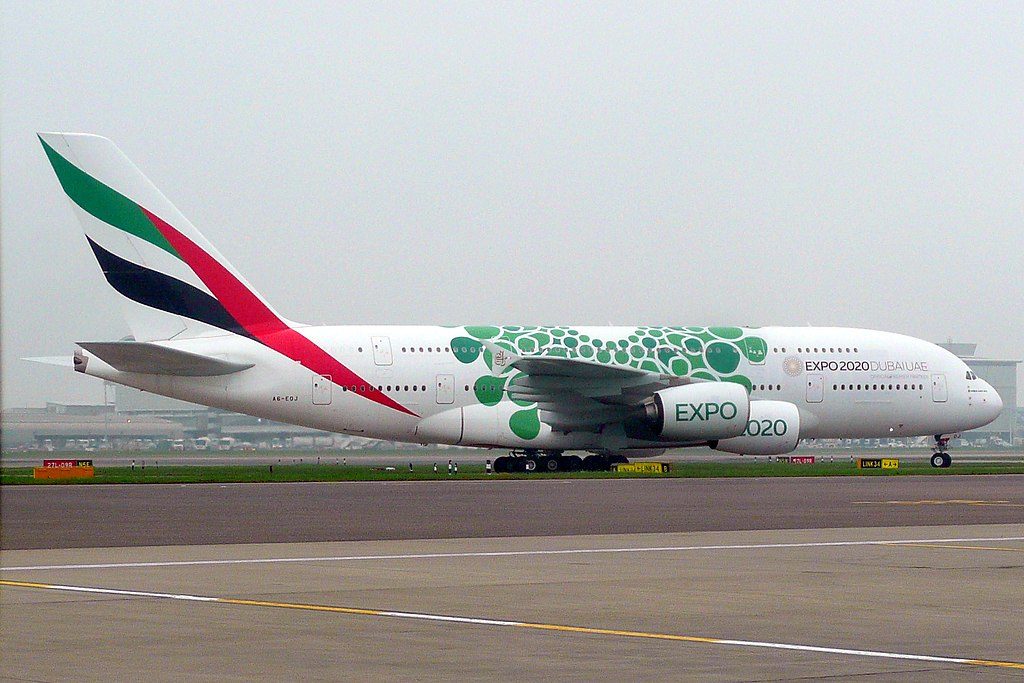
For passengers with babies the seats 6D and 6G offer bassinet locations.
Proximity of the galley and lavatories may represent a problem.
The seats 7A and 7K are good seats because they have extra legroom as well as the seats 22DG, 23A and 23K.
Passengers with infants are often seated on the seats 22DG.
The seats of the last 26th row are standard but close location of the bar and lavatories may be bothersome.
Seat Map and Seating Chart Airbus A380-800 Emirates Two Class Lower Deck

The third version of Airbus A380-800 operated by Emirates may transport 615 passengers in two classes: business and economy.
The lower deck contains 437 seats of the economy class.
Most of the seats in the economy class have 3-4-3 configuration.
Passengers of the seats of the 41st row will feel comfortable thanks to the extra legroom that these seats offer.
However, protrusion of the exit doors restrict this extra legroom of the seats 41A and 41K.
In addition other passengers tend to congregate in the area of these seats while waiting to use lavatories.
Due to bulkhead position the seats 45DEFG have extra space for passengers’ legs.
Proximity of the galley and limited recline are the main disadvantages of the seats 50ABC, 50HJK and 51DEFG.
The seats of the 52nd row are often reserved for passengers with babies.
The seats 52ABC and 52HJK have such an advantage as extra legroom.
The seats 52DEFG on the contrary have limited legroom because of the bulkhead position.
The noise coming from the galley may be bothersome for passengers of the seats of the 52nd row.
The seat 65H has such a disadvantage as close location of the lavatories.
Proximity of the lavatories is also disadvantage for passengers of the seats 65ABC, 65DEFG and 66HJK.
Also these seats are less reclining than standard.
Passengers of the seats of the 67th row will take advantage of extra legroom.
However, proximity of the lavatories may cause discomfort.
As there are no seats in front the seats 68A and 68K offer extra space for passengers.
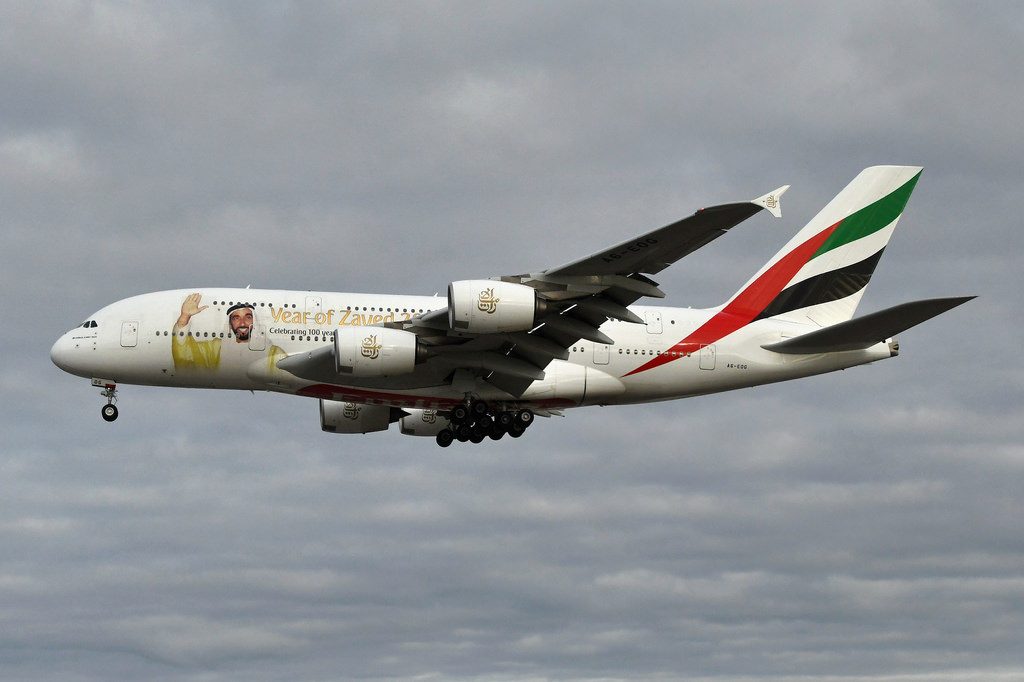
Close location of the galleys and limited recline are the disadvantages of the seats 78DEFG, 79ABC and 49HJK.
Extra legroom is the main advantage of the seats of the 80th row and the seats 81DEFG.
Among disadvantages: close location to the galleys the noise from which may cause inconvenience.
Protrusion of the exit doors inside is another disadvantage of the seats 80A and 80K.
Passengers traveling with infants are often seated on the seats 81DEFG as they offer bassinet locations.
Passengers tend to gather in the area of the last rows of the airplane in order to visit lavatories and thus causing discomfort to passengers of the seats 87C, 87DEFG, 87H and of the seats of the 88th row.
Also the seats 87DEFG, 88ABC and 88HJK are less reclining than standard that is why these seats are considered bad seats.
Seat Map and Seating Chart Airbus A380-800 Emirates Two Class Upper Deck

The Upper deck of the Airbus A380-800 includes 120 seats of the economy class and 58 flat bed seats of the business class.
Because of the bulkhead position the seats of the 24th row have limited space for passengers’ legs.
Another disadvantage of these seats is proximity of the galleys and lavatory.
As to the seats 25DEFG passengers of these seats on the contrary will feel comfortable thanks to extra legroom.
However, the noise from the galley and lavatories may represent a problem.
Close location of the galleys and lavatory may also represent a problem for passengers of the seats of the 39th row.
Behind the exit row the seats of business class are located. Most of the seats here have 2-4-2 configuration.
The only disadvantage of the seats 6A, 6EF and 6K is close location of the galleys and lavatory.
The best seats of the business class are considered the seats 19DG, 20A and 20K.
These seats offer extra legroom to passengers.
Proximity of the bar may be bothersome for passengers of the seats of the last 23rd row.
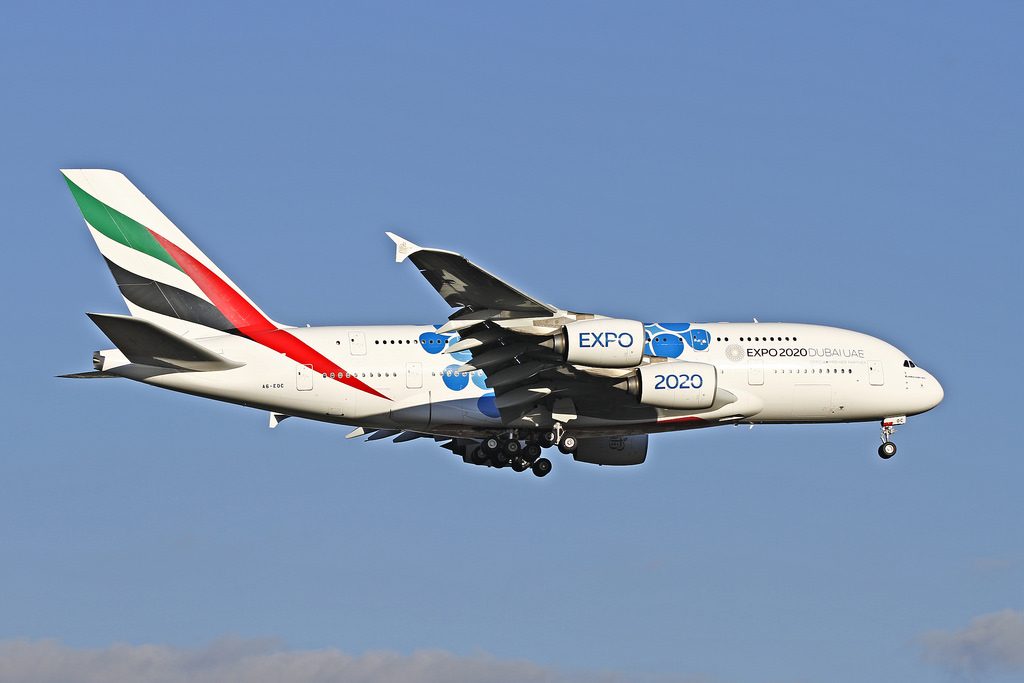
Airbus A380-800 Emirates Aircraft Fleet Inflight Amenities Information
- Audio. Each seat is equipped with personal Audio Visual on Demand (AVOD) via Emirates’ ICE entertainment system. There is an extensive menu of audio and music tracks available. More Information
- Video. Each seat is equipped with personal Audio Visual on Demand (AVOD) via Emirates’ ICE entertainment system. There is an extensive menu of movies, television programmes and video games available. More Information
- AC Power. Every First and Business Class seat is equipped with a regular 110v AC power port. In Economy, the power ports are located between the seats.
- Internet. This aircraft features a WiFi hotspot provided by OnAir, which allows passengers to pay for internet access using their credit cards.
- Food. Complimentary food and bar service are available on all Emirates flights.
Emirates Aircraft Fleet Wide-Body Airbus A380-800 Images Gallery



















Thanks to visiting AirlinesFleet.com and read article : Emirates Fleet Airbus A380-800 Details and Pictures.